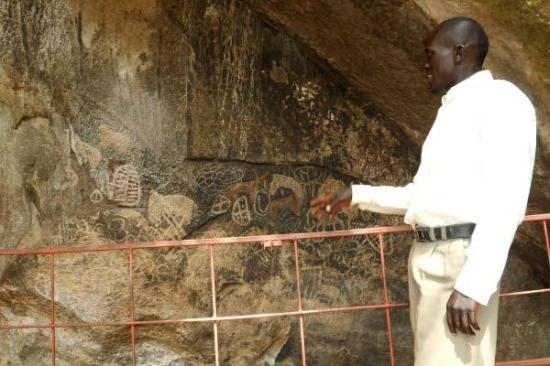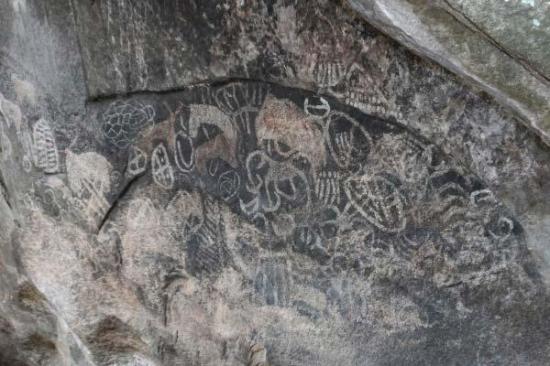Source - http://www.the-star.co.ke/news/stone-art-proves-western-kenyas-4000-year-history?#sthash.IHlaRs1C.dpuf
Three caves and ancient stone art at a cultural centre near Malaba have now provided one of the missing links in the study of human settlement and migration in Western Kenya.
Archaeologists have discovered that the caves were inhabited by people more than 4,000 years ago.
 Kakapel National Monument and Cultural Centre curator Anthony Odera shows some of the drawings and paintings in one of the caves at the heritage site. Archeological research has shown that some of the artworks inside the caves are over 4,000 years old. Photo/ EMOJONG OSER
Kakapel National Monument and Cultural Centre curator Anthony Odera shows some of the drawings and paintings in one of the caves at the heritage site. Archeological research has shown that some of the artworks inside the caves are over 4,000 years old. Photo/ EMOJONG OSER
The caves, part of the Kakapel National Monument and Cultural Centre, also feature distinctive paintings and inscriptions that archaeological research shows could have been made in the 17th century.
Most of the drawings measure approximately half a metre and are evidence of the sophistication of early settlers who curved out stones without benefit of modern tools.
The cross carvings are the oldest features, according to researchers from the National Museums of Kenya (NMK), who dated the artworks using carbon dating technology.
“Archaeologists from the National Museums of Kenya and the Trust for African Rock Art (TARA) came here in 2004,” Anthony Odera, the cultural Centre’s curator said.
“They discovered that the oldest artwork was designed more than 4,000 year ago. There are however superimpositions which were done 2,000 later.”
 Some of the prehistoric paintings and drawings inside one of the caves at the Kakapel National Monument and Cultural Centre. Archeological research has shown that some of the artworks inside the caves are over 4,000 years old. Photo/ EMOJONG OSERE -
Some of the prehistoric paintings and drawings inside one of the caves at the Kakapel National Monument and Cultural Centre. Archeological research has shown that some of the artworks inside the caves are over 4,000 years old. Photo/ EMOJONG OSERE -
A superimposed drawing is one that is drawn on top of an illustration sketched earlier.
Odera says the approximation of the time when man lived in the caves is also based on the interpretation of the rock painting depiction of environmental protection, rain making as well as fertility rituals, mainly done by hunters and gatherers.
He says the site receives both local and international visitors.
“This is clear evidence that human life once existed here. There are also pottery, grinding stones and dark smoke colourings on the walls of the caves.”
He says the dark smoke colouring shows that the cave’s residents cooked there.
During December last year’s Teso Cultural Festival in Kakapel, the site hosted more than 10,000 visitors from within East Africa and Europe.
Scientists are now using the artifacts to reconstruct the history of Iteso people.
Iteso traditions relate that they originated somewhere in what is now Sudan and moved south over a period of centuries.
It has not been possible to calculate the time of this movement. A body of Iteso is said to have separated from the Karamojong and moved further south.
This may have been a very early separation because the clan names and ritual customs associated with the second of two distinctive groups of Karamojong and Jie people are not found among the Iteso.
The Kakapel artifacts are among recent primordial discoveries in Kenya.
Last month, scientists announced though the science journal Nature the discovery of stone tools estimated to be 3.3 million years in the badlands near Lake Turkana.
Stephen Emachar, a member of the Teso Council of Elders, says these discoveries are essential in helping the present generation understand early man’s way of life and the relationship that existed between man and the environment.
In reference to the discovery at Kakapel, Emachar says: “These people (cave’s inhabitants) performed sacrifices because in a typical African traditional society, a cross symbolises sacrifice.”
“Other people have however, interpreted this (cross-craving) as a foreshadow of an expected trouble which long time ago included occurrences of drought and diseases.”
“Drawings of animals on the other hand can be understood as a show of the relationship that people then had with animals. Basing on this connection, we can conclude that they were hunters.”
Emachar says tree paintings inside the caves tell how the ancient generation valued environmental protection and sustainability.
The site was in 2005 gazetted by the NMK as a national monument.
The project has also received support from the US State Department through the Ambassador’s Fund for Cultural Preservation, Safaricom Foundation and other private donors.
The Kenya Wildlife Service (KWS) is also finalising plans to install an electric fence to protect wild animals including monkeys and chimpanzees, which are set to be introduced at the centre to attract more visitors.
The cultural centre will also receive a reptile’s cage for different species of snakes.
Terry Little, the head of Tara, a Nairobi-based organisation that records the rock art heritage of Africa, said of the Kakapel heritage centre: “My best and most important memories are associated with people and sites. Cultural sites represent the same for communities, nations and the world. They are places where memories and lessons are passed down through generations. When cultural sites are destroyed, we lose an important link to our ancestors and history.”
Terry was among scientists invited to Kakapel to date the artworks discovered by locals in 2004.